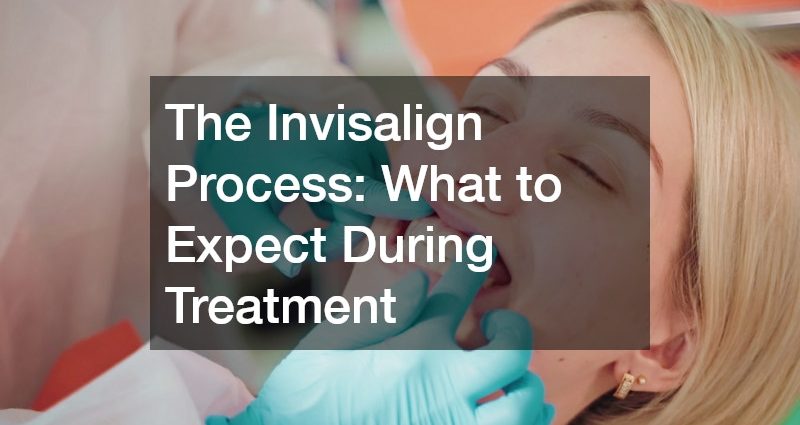
Invisalign has become a popular choice for individuals seeking a discreet and flexible solution to straighten teeth. Unlike traditional braces, Invisalign uses clear, removable aligners to gradually move teeth into their desired positions. Understanding the Invisalign process can help patients set realistic expectations, manage their treatment effectively, and achieve optimal results.
What is Invisalign and How Does it Work?
Invisalign is an orthodontic treatment system that uses a series of custom-made clear aligners to move teeth incrementally. Each aligner is designed to apply gentle, controlled pressure on specific teeth, guiding them into proper alignment. The system is nearly invisible, removable, and designed to provide comfort while maintaining daily routines.
Overview of Invisalign Technology
The core of Invisalign treatment is advanced 3D computer imaging. Dentists and orthodontists use digital scans to map each patient’s teeth, creating a virtual model that shows how teeth will move throughout the treatment process. This technology ensures precise planning and predictable outcomes.
Materials Used in Invisalign Aligners
Invisalign aligners are made from SmartTrack® material, a BPA-free, medical-grade thermoplastic. This material is both flexible and durable, allowing for consistent tooth movement while remaining transparent and nearly invisible.
The Importance of 3D Imaging in Invisalign
3D imaging plays a critical role in treatment planning. It allows dental professionals to simulate the tooth movement process, customize aligners for each stage of treatment, and provide patients with a visual representation of expected results before treatment even begins.
Customizing Aligners for Individual Patients
Based on the 3D scans, a series of aligners is manufactured to fit precisely and target specific teeth. Patients typically wear each aligner for one to two weeks before switching to the next in the series, gradually achieving the desired alignment.
Comparison with Traditional Braces
Invisalign offers several advantages over traditional braces, including:
-
Nearly invisible appearance
-
Removability for eating and cleaning
-
Reduced discomfort from wires and brackets
-
No dietary restrictions
How Long Does the Invisalign Process Take?
Factors Affecting Treatment Duration
The length of Invisalign treatment varies depending on the complexity of the case, age, oral health, and patient compliance. Mild crowding or spacing may require less time, while more severe bite issues may extend treatment.
Average Timeframe for Adults
For adults, treatment typically ranges from 12 to 18 months. Consistent wear of 20–22 hours per day is crucial to maintain the timeline.
Average Timeframe for Teens
Teen treatment is generally similar but may vary depending on ongoing dental development. Invisalign Teen aligners are designed with compliance indicators to help track wear time.
Tips for a Successful Treatment Timeline
-
Wear aligners as instructed
-
Attend regular check-ups
-
Handle aligners carefully to avoid damage
-
Maintain excellent oral hygiene
Adjusting to Aligners Over Time
Patients may experience mild pressure or discomfort when starting a new set of aligners. This is normal and indicates that teeth are moving. Most users adapt within a few days.
What are the Costs Involved with Invisalign?
Price Comparison: Invisalign vs. Braces
Invisalign treatment is often comparable in cost to traditional braces, although prices can vary based on the complexity of the case and geographic location.
Insurance Coverage for Invisalign
Many dental insurance plans cover a portion of Invisalign treatment, similar to coverage for traditional braces. Patients should check with their providers to understand coverage limitations.
Payment Plans and Financing Options
Many dental offices offer payment plans or financing options to make Invisalign more accessible. These plans allow patients to spread out costs over the treatment period.
Potential Additional Costs During Treatment
Some cases may require refinements or additional aligners, which could add to the overall cost.
Is Invisalign Cost-Effective in the Long Run?
Though Invisalign may have higher upfront costs than some alternatives, its durability, convenience, and minimal risk of complications often make it a cost-effective long-term investment.
What Can You Expect During the Treatment Process?
Initial Consultation and Assessment
Your dentist or orthodontist will evaluate your teeth, bite, and oral health, and discuss your treatment goals. Digital scans or impressions are taken to create your customized treatment plan.
Receiving and Wearing Your First Set of Aligners
The first set of aligners is fitted, and patients receive instructions on insertion, removal, and daily wear. Initial discomfort is common but usually subsides within a few days.
Regular Check-Ups and Adjustments
Appointments every 6–8 weeks allow the dentist to monitor progress, ensure proper tooth movement, and provide new aligners.
Managing Discomfort and Side Effects
Mild soreness or pressure is normal when switching aligners. Over-the-counter pain relievers, proper insertion techniques, and short adjustment periods can help.
Long-Term Maintenance of Results
After treatment, retainers are necessary to maintain alignment. Skipping retainer use may result in teeth gradually shifting back to their original positions.
What are the Advantages and Limitations of Invisalign?
Benefits of a Virtually Invisible Treatment
Invisalign is aesthetically pleasing, allowing patients to straighten teeth discreetly.
Impact on Lifestyle and Daily Activities
Because aligners are removable, patients can eat, drink, and maintain oral hygiene without major lifestyle changes.
Potential Challenges and Limitations
Invisalign may not be ideal for very complex orthodontic cases, severe bite issues, or poor compliance with daily wear recommendations.
Comparative Effectiveness for Different Cases
Mild to moderate alignment and spacing issues respond best to Invisalign, while traditional braces may be more effective for severe orthodontic challenges.
Success Rates and Patient Satisfaction
Clinical studies and patient surveys report high satisfaction rates, with Invisalign providing predictable, comfortable, and effective results when used correctly.
Invisalign offers a modern, discreet, and effective alternative to traditional braces. From the initial consultation to wearing aligners and maintaining long-term results, understanding the Invisalign process helps patients achieve their best possible smile. Consulting with a qualified dental professional ensures a personalized treatment plan and maximizes the chances of a successful outcome.


